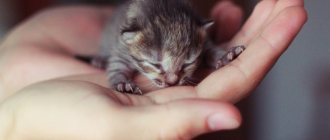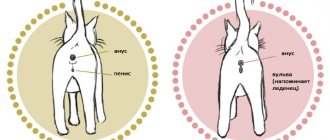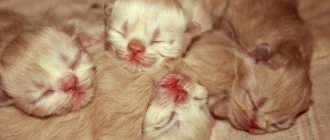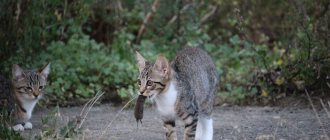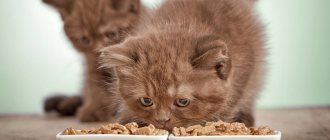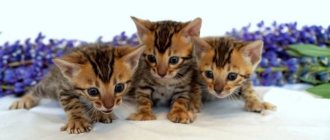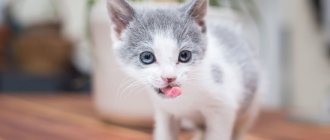Many breeders are interested in the question of what to feed a newborn kitten. For various reasons, mother's milk may simply be unavailable, and here a person must come to the animal's aid. This is very important, otherwise the baby will simply die.
Unfortunately, sometimes you can find a very sad discovery on the street. We are talking about small furballs that careless owners simply throw out to the mercy of fate, because they do not want to mess with their cat’s offspring. A kind person can take these babies, but problems arise with what food to give them and how long to feed newborn kittens, and the chosen products must replace the cat's milk and not harm the little body.
The best replacement for mother's milk may be a special infant formula
If newborn kittens are lucky enough to fall into the hands of kind people, or a domestic cat simply refuses to feed its offspring, there are several ways to solve this problem. If a person has the desire and patience, he will succeed in everything, even delivering newborn kittens.
Rules for caring for a newborn kitten
If a person nevertheless decides to shelter an abandoned four-legged baby and give him a chance for a normal life, he needs to think not only about what to feed the newborn kitten, but also in what conditions it will live. In addition to regular feeding, these little lumps require additional care. In a normal situation, the mother provides everything necessary for her babies. If the kittens were picked up by a person, the care of them falls entirely on his shoulders.
After eating, the kitten needs to massage its tummy
First of all, the adoptive parent must control the weight of their children. They should not be overfed, but kittens should not be too thin either. It is considered normal if a kitten gains 15 g per day.
You also need to remember that at first babies may have problems with bowel movements. A person must help the small stomach digest food. To do this, you need to periodically massage the kittens' belly. Usually cats lick their babies after feeding, which is a kind of massage. A person can do a similar procedure using a soft cloth soaked in water.
If the kitten has no health problems and the diet is completely suitable for him, the baby will go to the toilet 3-4 times a day. The feces should be light and not very liquid. If a kitten urinates yellow liquid, this indicates serious digestive problems. Most often, this happens when the kitten is constantly overfed. This situation is considered complex and dangerous, so in this case it is advisable to contact a specialist.
The kitten should be wiped with a damp cloth
Attention! The kitten must undergo hygiene procedures twice a day.
A person must help him with this. The baby's fur and face must be carefully wiped with a cloth soaked in warm water. This will be quite enough.
As for toilet training kittens, there is no need to rush this work. You need to start training your baby to use the tray no earlier than he switches to solid food and begins to eat on his own.
Feeding mode
The most important rule for successful artificial feeding is to regularly give kittens food, strictly at the same time, without skipping or delaying.
The regime must be observed both during the day and at night. Only in this way can we guarantee the health and full development of orphaned babies, as well as save their lives.
It is very important to adhere to a feeding schedule and regimen for small kittens. In the first months of life, the owners who take care of the babies will have to follow it around the clock:
- At the age of 1 week, kittens should eat every 2-2.5 hours.
- Starting from 2 weeks, they are fed according to the same scheme, but once every 3 hours.
- Upon reaching 3 weeks, kittens should be fed once every 4 hours during the day, and once every 5-6 hours at night.
The total number of feedings is about 6-7 throughout the day. However, if babies eat poorly and do not consume the established norm, which is from 30 to 40 g of complementary foods per 100 g of body weight, then the frequency of feedings must be increased.
With each weight gain, the daily amount of food, milk replacer or formula should also increase by an average of 3.5-5 g. The older the kittens become, the longer the pauses and breaks between feedings may become, especially at night.
Types of milk in a cat's diet
The most popular types of milk that owners can offer their pets are cow's and goat's.
Their comparative composition is given in the table.
| Index | Cow's milk | Goat milk |
| Fat content | 2,2 – 6,8 % | Average 4.5% |
| Vitamins | A; B1; B2; B6; B12; D; C. | A, D, E, C, B1, B2, B4, B5, B6, B12, H, PP, nicotinic acid. |
| Microelements | Calcium, potassium, phosphorus. | Calcium, potassium, phosphorus, magnesium, sodium, molybdenum. |
| Lactose content | High. | Minimal. |
| Calorie content, ml/100 g | 60 | 68 |
Despite the fact that goat milk has a high fat content, its composition is basically similar to cat and human breast milk, it contains more proteins, micro- and macroelements, and higher calorie content. At the same time, there is practically no alpha lipase, which causes the formation of fatty deposits.
Therefore, goat's milk is much preferable in pet nutrition than cow's milk:
- easier to digest;
- contains many lacto- and bifidobacteria, which improve digestion and gastrointestinal function;
- hypoallergenic, as it contains no proteins;
- minimal lactose content;
- lots of vitamins and minerals.
Corner for kittens
Along with the question of what to feed a newborn kitten, you need to think about organizing its personal space. To do this, you can select a corner in a warm room. The room should be well ventilated, but without drafts. Under no circumstances should you place a bed for newborn cats near a radiator.
It is best if the air temperature is within 30 °C. Over time, you can reduce the temperature to 24 °C.
You cannot place a bed for newborn cats near a radiator.
To prevent the kids from crawling away and harming themselves, it is necessary to equip them with a box. It must be covered with a soft cloth, which must be changed promptly if the kitten goes to the toilet. It is best to use natural materials, for example wool. You can place soft toys in the box so that the little ones snuggle up to them like they would to their mother.
Is milk acceptable in the diet of an adult cat - benefit or harm?
Veterinarians and nutritionists advise excluding milk from a cat’s diet from 6 months, and some experts suggest doing this earlier - as early as 4 months.
This is due to the fact that this product contains a special element in huge concentration - milk sugar. Its breakdown is carried out in the cat's body under the influence of the enzyme lactose.
The body of any mammal produces quite a lot of it in infancy and childhood and produces practically none at all in adulthood.
The consequence of feeding an adult cat milk, especially cow's milk, is a malfunction of the gastrointestinal tract, the occurrence of dyspeptic symptoms - nausea, vomiting, diarrhea.
This theory is confirmed by almost all experts - product rejection occurs in most individuals, but there are exceptions to the rule.
Some adult and even elderly pets happily drink milk without any consequences for the proper functioning of the body. This is due to the individual characteristics of specific individuals. This means that it is in their body that a lot of lactose is still produced and the breakdown of milk sugars occurs successfully.
All adult animals like the taste of milk, but numerous studies have confirmed that it does not bring any benefit to the pet. Some cats, even in the absence of dyspeptic symptoms, may develop an allergic reaction when feeding them milk.
Thus, despite the assertion of some scientists about the indispensability of cow's milk in the diet of cats, most experts recognize this product as harmful and unacceptable in the diet of adult pets:
- The high calorie content of milk can lead to imbalance in the body and ultimately lead to obesity.
- The high content of casein and lactose does not allow the product to be completely absorbed.
- An extremely high concentration of elements that are unacceptable in the diet of an adult animal contributes to the development of allergies.
- Intolerance to milk sugars by the cat's body leads to indigestion, flatulence, bloating, indigestion, chronic diarrhea and dehydration.
Replacing milk with fermented milk products
If the cat is a dairy lover and is on a natural diet, it is better to gradually replace this product with a fermented milk menu.
Kefir, fermented baked milk, natural yoghurts not only do not contain milk sugars, but are also enriched with lactic acid bacteria, which have a beneficial effect on digestion and the functioning of the entire gastrointestinal system of the cat as a whole.
There is no lactose in these products; it is what is converted into lactic acid during fermentation.
Using various types of fermented milk products, you can regulate and eliminate intestinal problems in your pet. So, for example, in case of regular constipation, fresh kefir will help, and in case of diarrhea, “old” (two-day old) kefir.
You can offer your cat milk without or with low lactose content, but usually such products do not delight your pet.
When choosing kefir, or better yet biokefir or fermented baked milk, you should pay attention to the fat content in them. It shouldn't be high. That is why you should not often offer your cat high-calorie cottage cheese or cheese, much less sour cream.
It is unacceptable to feed your pet sweet yoghurts and curds containing a lot of sucrose. Sugar is another harmful and dangerous human product for cats.
Where would we be without vitamins?
When artificially feeding, the kittens' diet must include specialized supplements and vitamin complexes to compensate for the deficiency of those substances that babies receive from mother's milk. A veterinarian will help you choose the right drug and determine the dosage.
Special supplements that are well suited for 2-week-old babies include:
- Trivit (1 drop each);
- glucose (1 to 2 g during feeding);
- bone and meat flour (an excellent source of calcium for bones, tooth enamel and joints and ligaments of children);
- fish oil (1 drop once a week) – perfectly enriches the body with vitamins D;
- vitamin A;
- vitamin E;
- vitamin D;
- a preparation containing B vitamins.
It is important to take into account the fact that ready-made cat milk substitutes and formulas already contain a certain amount of vitamins, and most supplements are designed for kittens one month and older.
An excess of substances can be just as dangerous to the health of children as their deficiency, so it is necessary to correctly calculate the optimal dosage of each drug.
How to feed a newborn kitten?
After the problem of what to feed a newborn kitten has been solved, all that remains is to choose the method by which the food will be delivered to the baby’s mouth. It must be remembered that in this case we are talking about a very small animal that cannot yet eat on its own.
One of the rather convenient methods is a regular syringe, from which you must first remove the needle. A pipette is also suitable, but it is not very convenient and takes a long time. You can try using a bottle to feed your baby. There are also special bottles for small kittens, which can be purchased in specialized stores.
Important! When eating, the animal must lie on its stomach, otherwise the kitten may simply choke.
A person must control the amount of food that goes into the baby’s mouth. It is necessary that the kitten not only does not choke, but also does not swallow excess air, as this can cause the development of flatulence. It is advisable not to use bottles or other products with a large hole for feeding. If there is too much fluid released, it will begin to enter the kitten's respiratory tract, and it will suffocate. During feeding, the bottle should be held at an angle of 45 °C.
During feeding, keep the bottle at an angle of 45 ° C
As for how often to feed a newborn kitten, before the age of 1 week, food should be given often, but little by little. It is advisable to carry out this procedure every 2 hours. If the question arises as to how many times a day to feed a newborn kitten, then at 2 weeks you can already switch to five meals a day, and from 3 weeks - to three meals a day. Gradually, the amount of food must be increased so that the stomach gets used to it and works better. It is very convenient to use a syringe in this regard, as it makes it possible to measure the amount of liquid as clearly as possible.
As for how much to feed a newborn kitten, as a rule, the process takes about 5 minutes. During this time, the baby will have time to eat and get tired. Most often, kittens become so full during this time that they simply fall asleep immediately. It should be taken into account that if the animal eats too little at one time and falls asleep, after waking up you need to give the kitten more food. Otherwise, he will not get enough and will remain hungry. But you should not force feed your baby. If he doesn't want to eat now, you can offer him a bottle of food in 20-30 minutes. During this time, the newborn kitten will definitely work up an appetite. If he constantly refuses food, then it’s worth trying a different formula, or even better, show the baby to the doctor.
After feeding, the newborn kitten will get tired and fall asleep
After feeding, you need to stroke the kitten's belly so that it can burp. Thus, feeding a small kitten becomes very similar to feeding a baby. In this case, similarly, it is necessary to maintain sterility, and the room where the baby is staying must be very clean. The room for a newborn kitten should be warm, but not hot and without drafts.

